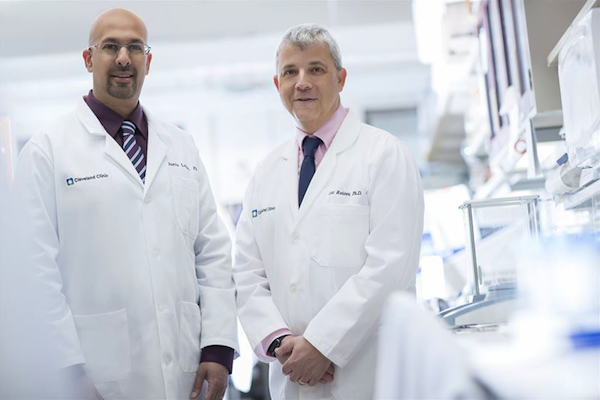Members Login

Channels
Special Offers & Promotions
New Research Uncovers How Cancer Stem Cells Drive Triple-Negative Breast Cancer
Findings published in Nature Communications identify stem cell survival pathway, which may serve as a potential target for new breast cancer therapies
A team of researchers in the United States has identified a new stem cell pathway that allows a highly aggressive form of breast cancer – triple-negative breast cancer – to thrive, with their findings potentially pointing the way towards new, more effective treatments in cases where hormone therapy has proved unsuccessful.
Hormone therapy for breast cancer blocks cancer cells from interacting with hormones such as estrogen and progesterone, which fuel the cancer cells to grow and spread. However, triple-negative breast cancer cells lack the receptors needed to bind to these hormones and growth factors. Without such receptors, typical therapy does not work, contributing to poor survival rates for women with this subtype of breast cancer.
Researchers at the Cleveland Clinic Lerner Research Institute believe that an aggressive population of cancer cells, called cancer stem cells, is at the heart of why many cancers, including triple-negative breast cancer, are challenging to treat. Cancer stem cells self-replicate, rapidly grow and spread, and change their phenotype in response to the tumor environment.
In findings published in Nature Communications, the new study led by Justin Lathia, Ph.D., and Ofer Reizes, Ph.D. identifies a never-before described survival pathway in cancer stem cells that may serve as a potential target for new triple-negative breast cancer therapies.
“Triple-negative breast cancer is resistant to treatment and has a high recurrence rate,” Reizes said. “This aggressive subtype accounts for about 15-20 percent of breast cancers. Our findings are at an early stage but we are hopeful that targeting these cancer stem cells will lead to new treatments to allow women to be treated successfully and improve their outcomes.”
The team studied a protein called connexin 26 (Cx26), which belongs to the connexin class of proteins. While once believed to suppress tumors, recent research suggests that connexins may actually support tumor progression by aiding in cell-to-cell communication.
The researchers compared healthy breast tissue to triple-negative breast cancer tissue and found that Cx26 is the most highly expressed connexin in diseased tissue vs. normal breast tissue. They also observed that Cx26 levels are higher in cancer stem cells than non-cancer stem cells and that the protein is expressed inside the cell rather than on the cell surface. The researchers also found that Cx26 is linked to two other proteins known to independently promote tumor maintenance and growth.
“Additional research is needed, but this discovery suggests that inhibiting Cx26 and the related pathway may be a promising new strategy for stopping or preventing triple-negative breast cancer stem cells from self-renewing and spreading,” Lathia said. “It may also offer a target for diagnostic testing that helps clinicians predict health outcomes and relapse-free survival for patients with a specific cancer type.”
This study was supported by National Cancer Institute grant (R21 CA191263). Reizes holds the Laura J. Fogarty Endowed Chair for Uterine Cancer Research.
About Cleveland Clinic
Cleveland Clinic is a nonprofit multispecialty academic medical center that integrates clinical and hospital care with research and education. Located in Cleveland, Ohio, it was founded in 1921 by four renowned physicians with a vision of providing outstanding patient care based upon the principles of cooperation, compassion and innovation. Cleveland Clinic has pioneered many medical breakthroughs, including coronary artery bypass surgery and the first face transplant in the United States. U.S. News & World Report consistently names Cleveland Clinic as one of the nation’s best hospitals in its annual “America’s Best Hospitals” survey. Among Cleveland Clinic’s 51,000 employees are more than 3,500 full-time salaried physicians and researchers and 14,000 nurses, representing 140 medical specialties and subspecialties. Cleveland Clinic’s health system includes a 165-acre main campus near downtown Cleveland, 10 regional hospitals, more than 150 northern Ohio outpatient locations – including 18 full-service family health centers and three health and wellness centers – and locations in Weston, Fla.; Las Vegas, Nev.; Toronto, Canada; Abu Dhabi, UAE; and London, England. In 2016, there were 7.1 million outpatient visits, 161,674 hospital admissions and 207,610 surgical cases throughout Cleveland Clinic’s health system. Patients came for treatment from every state and 185 countries.
About the Lerner Research Institute
The Lerner Research Institute is home to Cleveland Clinic's laboratory, translational and clinical research. Its mission is to promote human health by investigating in the laboratory and the clinic the causes of disease and discovering novel approaches to prevention and treatments; to train the next generation of biomedical researchers; and to foster productive collaborations with those providing clinical care. Lerner researchers publish more than 1,500 articles in peer-reviewed biomedical journals each year. Lerner's total annual research expenditure was $260 million in 2016 (with $140 million in competitive federal funding, placing Lerner in the top five research institutes in the nation in federal grant funding). Approximately 1,500 people (including approximately 200 principal investigators, 240 research fellows, and about 150 graduate students) in 12 departments work in research programs focusing on heart and vascular, cancer, brain, eye, metabolic, musculoskeletal, inflammatory and fibrotic diseases. The Lerner has more than 700,000 square feet of lab, office and scientific core services space. Lerner faculty oversee the curriculum and teach students enrolled in the Cleveland Clinic Lerner College of Medicine (CCLCM) of Case Western Reserve University - training the next generation of physician-scientists. Institute faculty also participate in multiple doctoral programs, including the Molecular Medicine PhD Program, which integrates traditional graduate training with an emphasis on human diseases. The Lerner is a significant source of commercial property, generating 64 invention disclosures, 15 licenses, 121 patents, and one new spinoff company in 2016.
Media Partners



